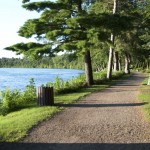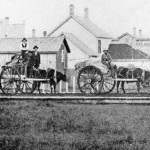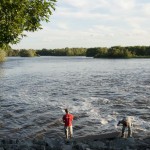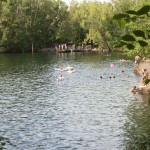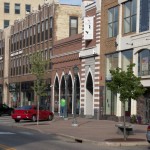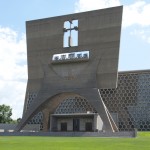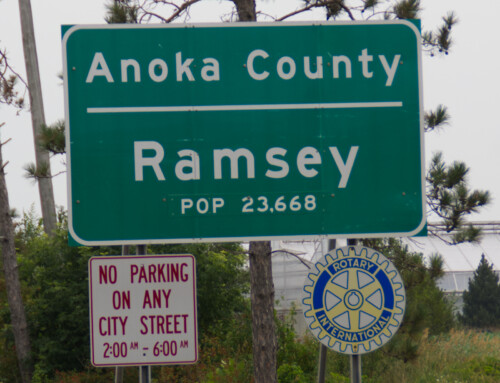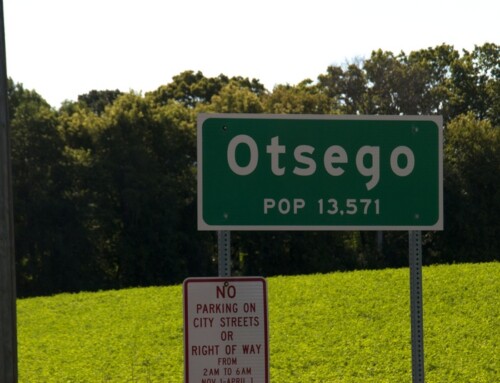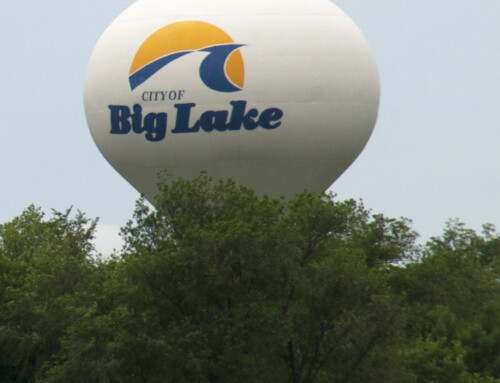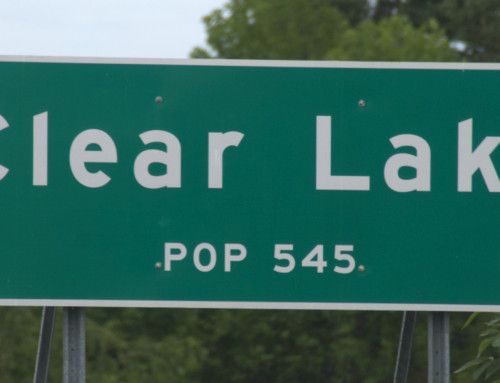Introduction
St. Cloud, a city split between three counties, emerged from the union of three distinct cities: one founded by a slave-owning southerner, one founded by an abolitionist Protestant, and one created just to build a sawmill. It’s a wonder the place ever came up with a cohesive identity.
Visitor Information
Direct your questions to the St. Cloud Area Convention & Visitors Bureau (320.251.4170).
History
St. Cloud emerged from the tallgrass prairie that bordered hardwood forest. The landscape dictated the location of early settlements, as deep ravines divided one part of the area from another. Upper Town was above the northern ravine along the Mississippi River; Lower Town was below the southern ravine; Middle Town was right between them. Settlement began in all three areas between 1853 and 1855.
The first area to attract settlement was Upper Town. In 1853 Sylvanus B. Lowry, a transplant from Tennessee, made a land claim above the northern ravine. Lowry owned slaves and brought some with him, even though slavery was supposed to be off-limits in the Minnesota Territory. Even as he developed his new city, which he named Acadia, he managed fur trading posts at Watab and Sauk Rapids and worked as an interpreter. In short order, other wealthy Southerners followed Lowry to Acadia. When the Civil War began, however, Southerners abandoned Acadia and the city became an isolated residential community.
At the opposite end of town (and the opposite end of the cultural spectrum), George Fuller Brott (a New Yorker) bought a claim from squatter Martin Wooley to create Lower Town. He platted the site as St. Cloud City and attracted settlers from New England, most of whom were were committed abolitionist and temperance advocates. By 1857, the city had a hundred buildings, including the Stearns Hotel which was a favored location for Southerners escaping the heat. Development of lower town was slowed by disputes over land claims, however, as some of the city’s land was deeded to the St. Paul & Pacific Railroad before the original official city plat was completed, which created a bit of confusion over who owned what. Rather than wait out the uncertainty, many businesses just moved to Middle Town, with some taking their buildings with them. Like Upper Town, Lower Town became mostly residential.
Which brings us to Middle Town. John Lyman Wilson bought the 320-acre claim of Ole Bergeson (another squatter) for $100 and commenced building a settlement. Wilson was a millwright from Maine who arrived in the area in 1851 and built sawmills at other places in Minnesota. When he platted Middle Town, he reportedly chose to name the city St. Cloud after a French suburb that had ties to Napoleon. Wilson read much about his life and recalled an incident about Napoleon when he was fighting Russia. His wife, Josephine, had taken up residence at their summer home in St. Cloud; when messengers arrived to deliver news from France, Napoleon asked, “And how are things in St. Cloud?” Ah, but who was the St. Cloud that the Paris town is named for?
Clodoald was one of four sons of Clovis, the King of the Franks. When Clovis died in 511, it triggered a battle for the throne that left three of Clodoald’s brothers dead. Clodoald barely escaped death, fleeing to the sanctuary of a hermit life where he studied under St. Severinus and renouncing any claims to his father’s throne. Clodoald, which translated into French as Cloud, was eventually ordained a priest and established a shrine at Nogent-sur-Seine where his relics are now kept in a church called St. Cloud; the village of Nogent-sur-Seine later changed its name to St. Cloud, as well. If your profession involves manufacturing nails or if you suffer from carbuncles, he is your patron saint.
Back to Middle Town. It was located more-or-less where today’s downtown St. Cloud is situated, and was settled primarily by German Catholics, many of whom were part of a settlement society from Evansville, Indiana that was led by John W. Tenvoorde (who was Dutch but grew up in Germany). As late as 1858, Middle Town had only about a dozen families in residence, some of whom were Germans who moved from Sauk Rapids because they weren’t allowed to brew beer there.
These three cities were united into one by an act of the Minnesota Legislature in March 1856, with the name St. Cloud winning the day. St. Cloud began to develop rapidly, which may have prompted an anonymous—and jealous—neighbor to call it: “a small but pretentious suburb of Sauk Rapids.” Lowry began ferry service across the Mississippi River in 1856; Wilson and Brott soon followed suit. St. Cloud had some steamboat traffic from Minneapolis before the Civil War, but water levels on the river varied too widely for dependable service.
While river traffic was somewhat limited, St. Cloud was strategically located on one of the main overland stops for oxcarts traveling the Red River Trail. Perhaps because of the Red River Trail, the freight business took off in St. Cloud. Brothers James Crawford and Henry Clay Burbank established a freight business that employed coaches and a steamboat, with St. Cloud as the hub.
All was not peachy keen between folks in town, however. Jane Grey Swisshelm arrived in St. Cloud in 1857 and founded the St. Cloud Visitor, a paper that served as a forum for condemning slavery and its supporters. As you might guess, she and Lowry—who served as the first mayor of a unified St. Cloud—had a hard time getting along. While she lauded his intellectual and leadership abilities, she attacked his support of slavery, writing: “his life spent among Negroes and Indians made him feel his superiority and assert it with the full force of honest conviction.” Her office was ransacked at least once, but support from the community helped her rebound. Swisshelm left St. Cloud when the Civil War started, first working as a nurse tending the Union’s wounded soldiers, then as an adviser to President Lincoln.
St. Cloud boomed after the Civil War, growth that was fueled in part by the arrival of the railroads and the rise of the granite quarrying industry. Granite quarrying began around 1863 but really picked up after the Civil War. By 1920 there were 20 active quarries employing 2,500 men, including many Scots and Swedes. Granite from these quarries helped build the Cathedral of St. Paul and the Minnesota State Reformatory for Men at St. Cloud; the latter is surrounded by a granite wall that is 1,700 yards long, 4½ feet thick at the base, and 22 feet high. You’ll also notice that many streets that dead end at the Mississippi have granite walls; these were built by the Works Project Administration in the 1930s, with granite donated by local companies. Granite quarrying, however, was rough on the health of quarrymen. Many developed silicosis from breathing the dust; methods to protect workers from silicosis were not perfected until 1970.
Meanwhile, the Great Northern Railroad erected a rail yard that quickly became the largest employer in town; today it houses a repair facility for Burlington Northern. The community around the yard eventually incorporated as Waite Park. Other early businesses in the area included a number of breweries, sash and door manufacturing, cigar shop, iron works, and flour mills.
A tornado hit the area on April 14, 1886, killing 20 and injuring 75 in St. Cloud, but neighboring Sauk Rapids suffered even more.
The Pantown Neighborhood Historic District is on the west side of the city (8th Street North from 33rd Avenue North to 29th Avenue North). The craftsman-style homes were built between 1917 and 1919 for employees of Samuel Pandolfo’s Pan Motor Company.
While politicians of the past may have promised a “chicken in every pot,” during Prohibition they could have pledged “a still in every home.” Those stills provided a second income for many folks in the St. Cloud region, including quite a few farmers. Law enforcement was usually willing to look the other way for local moonshiners. Most folks produced the mash by fermenting a hybrid corn called Minnesota 13 that was developed at the University of Minnesota. It should be no surprise that the local moonshine therefore became known as Minnesota 13, even gaining an international following.
After World War II, the city began to come to come to grips with the fact that over half of its property was exempt from property taxes and that much of the new retail and housing stock was being built outside of the city limits. The city responded by annexing some of those areas.
Today, St. Cloud’s largest employer is St. Cloud Hospital (3,367 employees), followed by the State of Minnesota (2062), Electrolux Home Products (1800), Coborns (1733), Saint Cloud State University (1450), and Gold ‘n Plump Poultry (1200). As you drive around, you may notice a few unfamiliar fast-food chains; that is because St. Cloud is a favored testing ground for fast food chains.
Exploring the Area
The Stearns County History Center (235 33rd Ave. S; 320.253.8424) is the place to research local or family history or just to leisurely take in the extensive exhibits on the region’s history.
The Cathedral of St. Mary (25 8th Ave. S; 320.251.1840) was completed in 1931, although the parish dates to 1854. The original Gothic-revival church opened in 1864 but was destroyed by a fire on August 25, 1920. Construction began a replacement in 1921 but it took a decade to complete it. The church you see today is Romanesque in design.
Quarry Park and Nature Preserve (1802 County Road 137; 320.255.6172) is a popular park in a reclaimed granite quarry. In summer, enjoy four miles of unpaved trails for hiking and mountain biking or find a rock climbing, hiking; in winter, those same trails are great for cross-country skiing.
The Paramount Theatre (912 W. St. Germain St.; 320.259.5463) is a multi-faceted arts venue, with an auditorium for live theater and music, as well as exhibits of visual arts in its Gallery St. Germain (912 W. St. Germain St.) and the theater lobby.
Pioneer Place on Fifth (22 5th Ave. S; 320.203.0331) hosts 8 major shows a year (drama, musicals, etc.), as well as concerts in an intimate setting that began life as an Elks Club in 1913. The adjacent Veranda Lounge hosts a Monday night jazz series.
River Bluffs Regional Park (3822 Clearwater Rd.) on the south end of town has good hiking and access to the river.
If you fancy a skate in winter, check out the Herb Brooks National Hockey Center (1204 4th Ave. S; 320.308.3327); aside from taking in a collegiate hockey game—St. Cloud State and Saint John’s both play home games here —you might be able to zip in for an hour or two of open skating or open adult hockey, which are generally around lunchtime and early evening, but call to confirm.
Sand Prairie Wildlife Management Area (320.255.4278) has 700 acres of native prairie remnants; on a hike through the area, you’ll see see a variety of plant and animal life, including the occasional sandhill crane. The area is 2 miles south of St. Cloud on US Highway 10, on the east side of the highway after passing County Road 7.
Parks along the River
The paved Beaver Islands Trail winds five miles along the west side of the Mississippi from 1st Street North to Clearwater Road at Montrose Road., basically from St. Cloud State University to River Bluffs Regional Park. Along the way, it passes through woods and near a couple of good overlooks of the river.
Clemens/Munsinger Gardens (1515 Riverside Dr. SE), is a lovely group of formal gardens along the riverfront. In season, a succession of blooming plants turns the riverfront into a Technicolor paradise. The 6 gardens that comprise Clemens Gardens include one for roses and another for perennials. Just below it, Munsinger Gardens is a showcase for plants that grow and flower in shade.
- Wilson Park (625 Riverside Dr. NE) and Hester Park (1020 6th Ave. N) are neighborhood parks on opposite sides of the river.
- Beaver Island Park (1503 3rd Ave. S) is 25 acres of scenic and serene riverfront property.
- Landing Park (Cummings Ln) and Edgewater Park (4390 Clearwater Rd) are on the city’s south side.
- St. Cloud River Bluffs Regional Park (522 38th St SE) is a relatively new park on the south end of town that has good hiking and access to the river.
Detour to St. Joseph and Collegeville
The St. Cloud area has a rich tradition of Catholic education. Just west of the city, the small communities of St. Joseph and Collegeville are home to two well-respected institutions. The two universities have a unique collaboration that allows students at one campus full access to the facilities at the other, including classes, events, and dining. A shuttle service runs regularly to link the two campuses. Both campuses have attractions that will interest visitors.
St. John’s University in Collegeville was established in 1857 by Benedictine monks from western Pennsylvania (via Germany). They first set up around St. Cloud’s Lower Town but moved to their current location in 1865.The campus is a model for balancing the demands of a 21st century educational institution with land stewardship. The campus is about a 25-minute drive from downtown St. Cloud via Division Street, County Road 75, and Interstate 94.
Saint John’s Benedictine Abbey Church is a stunning modernist building designed by renowned architect Marcel Breuer; the open interior is decorated with the world’s largest stained glass window.
The HILL Museum & Manuscript Library began in 1965 with the mission of preserving old European manuscripts. Much of what you’ll see on display right now are pages from Saint John’s Bible—completed in 2011 after 13 years of work, and the first illuminated Bible completed in 500 years.
Richard Bresnahan is a renowned potter and artist-in-residence at St. John’s University. Stop in to his pottery studio to learn about his art and mission to create sustainable pottery (St. Joseph Hall, 2810 Saint John’s Rd. in Collegeville; 320.363.2930; M-F 1:15-4:30 p.m., Sa 10 a.m. – 4:30 p.m.).
Benedictine sisters settled down the road in St. Joseph in the early 1860s. The monastery (104 Chapel Ln.) and adjacent College of St. Benedict is a 20-minute drive from downtown St. Cloud via Division Street and County Road 75.
The Sacred Heart Chapel is a beautiful baroque structure, blending traditional design with modern touches. The Whitby Gift Shop and Haehn Museum have exhibits on the past and present of the Benedictine sisters of St. Joseph.
The College of St. Benedict was established as a women’s college in 1913 focused on teacher education.
Getting on the River
Outdoors Endeavors at St. Cloud State University (720 4th Ave. S; 320.308.3325) rents canoes, kayaks, and camping gear for summer fun, as well as winter gear like snowshoes, sleds, and a portable ice house. You don’t need to be affiliated with the university to rent equipment.
Entertainment and Events
Quarterly Art Crawls give folks a chance to wander around downtown St. Cloud and check out the works of local artists. The events take place on a Friday in March, June, August, and November, but the August event is so much bigger than the rest that it gets its own name: The Sizzling Summer Art Crawl.
The St. Cloud Municipal Band (320.308.3223) has been performing for the locals for over 110 years. Look for summer performances in Barden Park (720 5th Ave. S), the city’s oldest park.
Farmers Market
The St. Cloud farmers market gathers on Saturday mornings from early May through October at the Lady Slipper parking lot (198 7th Ave. S.).
Festivals
Summertime by George brings live music and a festival atmosphere to the shores of Lake George in Eastman Park (425 E. Lake Blvd.) for 12 Wednesday evenings between mid-June and the end of August; there are free shuttles from downtown to the park.
In June, St. Cloud celebrates its existence with Granite City Days (320.255. 7201), a long weekend of fun that includes a singing competition, canoe trips around the Beaver Islands, the Lemonade Art Fair, and the required parade.
St. Cloud’s annual Winter Nights and Lights Festival is a good excuse to get out of the house at the beginning of cold season, and it even culminates in a parade that marches through downtown (mid-December).
**St. Cloud is covered in Road Tripping Along the Great River Road, Vol. 1. Click the link above for more. Disclosure: This website may be compensated for linking to other sites or for sales of products we link to.
Where to Eat and Drink
Beaver Island Brewing Company (216 6th Ave. S; 320.253.5907) has a taproom open Thursdays through Sundays.
Jules Bistro (921 W. St. Germain St.; 320.252.7125) prepares an impressive variety of pastries and baked goods, from scones to macarons to tarts. They also prepare fresh soups, salads, sandwiches, and flatbreads if you’re looking for a good meal. Try shakshuka for breakfast.
The Veranda Lounge (22 5th Ave. S; 320.258.0254), which is adjacent to Pioneer Place on Fifth, is primarily a wine bar, but they also serve snacks and flatbreads.
Arroy (800 W. St. Germain St.; 320.240.1454) serves tasty Filipino and Thai food, including a few catfish preparations that you’ve probably never had before.
Granite City Food & Brewery (3945 2nd St. S; 320.203.9000) may have grown into a regional chain, but they began in St. Cloud. This popular place is a good choice for small batch beer and good food.
The White Horse (809 W. St. Germain St.; 320.257.7775) specializes in creative, freshly prepared meals complimented by a fine selection of craft beer and adult beverages.
Locals have been flocking to the House of Pizza (19 5th Ave. S; 320.252.9300) since 1964; you can get just about any kind of pizza you desire and pair it with a craft beer, if that’s your thing. If pizza’s not your thing, they also have pasta, salads, and sandwiches.
The Pickled Loon (715 W. St. Germain St.; 320.281.3581) serves an impressive range of lighter fare and entrées that sample a variety of international cuisines; the menu changes with the seasons.
Anton’s Sea Galley on the Sauk River in nearby Waite Park (2001 Frontage Rd. N; 320.253.3611) is the place for fine dining in a casual setting; the popovers are beloved (for good reason), but they do a good job with the whole menu.
For something completely different, detour 20 miles to the town of Avon and check out Fisher’s Club (428 Stratford St.). Once owned in part by Garrison Keillor of Prairie Home Companion fame, the restaurant is well-known for its outstanding walleye dinners, charming ambiance, and views of Middle Spunk Lake (open W-Su from spring through December; call ahead to make reservations: 320.356.7372).
Where to Sleep
Downtown has a few chain motels but the highest concentration is around the intersection of Highways 15 and 23 west of downtown.
Camping
St. Cloud Campground & RV Park (2491 2nd St. SE; 320.251.4463) is located just east of St. Cloud on the outskirts of town and can accommodate anyone from tent campers to RVs.
Budget
The Night’s Inn (720 Highway 10 South; 320.255.1274) is an older mom-and-pop motel along US Highway 10; the rooms are in good shape and each has a microwave and small fridge
Getting There
Allegiant Air and Sun Country Airlines operate flights from St. Cloud Regional Airport (1550 45th Ave. SE; 320.255.7292).
St. Cloud is one of the stops along Amtrak’s Empire Builder route (555 E. St. Germain St.; 800.872.7245). Westbound trains headed for Seattle have a scheduled departure time of 1:09am. Eastbound trains depart early in the morning (6:32am) for Mississippi River towns Saint Paul, Red Wing, Winona, and La Crosse before continuing on to Chicago. The Empire Builder trains often run late.
Jefferson Lines offers long-distance bus service; the downtown St. Cloud stop (510 1st St. S) has a ticket office, while the stop at St. Cloud State University’s Atwood Center does not (651 1st Ave. S; across from the Caribou Coffee entrance). You may want to purchase tickets online (they are not refundable); you’ll need to print a boarding pass and be prepared to show an ID when you board. You can also buy a ticket on the phone (800.451.5333). If all else fails, you can show up without a ticket, and the driver may let you ride to the next station that sells tickets where you can buy one.
St. Cloud’s MetroBus offers a Northstar Link service (Route #887) that runs from the downtown transit center (510 1st St. S) to the Northstar commuter rail at Big Lake. It’s primarily for commuters, so it runs early in the morning and again in the afternoon and evening on weekdays (plus a couple of buses on weekends), but buses also run to get folks to and back from Twins baseball games and Vikings football games.
Where to Go Next
Heading downriver?
- On the east bank check out Clear Lake
- On the west bank, check out Clearwater
Heading upriver?
- On the east bank check out Sauk Rapids
- On the west bank check out Sartell
Community-supported writing
If you like the content at the Mississippi Valley Traveler, please consider showing your support by making a one-time contribution or by subscribing through Patreon. Book sales don’t fully cover my costs, and I don’t have deep corporate pockets bankrolling my work. I’m a freelance writer bringing you stories about life along the Mississippi River. I need your help to keep this going. Every dollar you contribute makes it possible for me to continue sharing stories about America’s Greatest River!
St. Cloud Photographs
- Sylvanus Lowry (Courtesy of Stearns History Museum, St. Cloud, MN)
- Oxcarts (Courtesy of Stearns History Museum, St. Cloud, MN)
- Jane Grey Swisshelm (Courtesy of Stearns History Museum, St. Cloud, MN)
- Quarry Park, St. Cloud, MN
- Riverfront park in St. Cloud
- Saint John’s Benedictine Abbey Church
A Song for St. Cloud
Stearns County Dirt by Leon Laudenbach (2014)
©Dean Klinkenberg, 2024, 2021, 2018,2013,2011
